

Universal Product Code. Composition[edit] Each UPC-A barcode consists of a scannable strip of black bars and white spaces, above a sequence of 12 numerical digits.
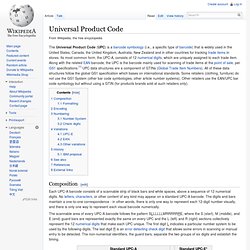
No letters, characters, or other content of any kind may appear on a standard UPC-A barcode. The digits and bars maintain a one-to-one correspondence - in other words, there is only one way to represent each 12-digit number visually, and there is only one way to represent each visual barcode numerically. The scannable area of every UPC-A barcode follows the pattern SLLLLLLMRRRRRRE, where the S (start), M (middle), and E (end) guard bars are represented exactly the same on every UPC and the L (left) and R (right) sections collectively represent the 12 numerical digits that make each UPC unique. The first digit L indicates a particular number system to be used by the following digits. Parachute Jump. This article is about the "Parachute Jump" amusement ride.
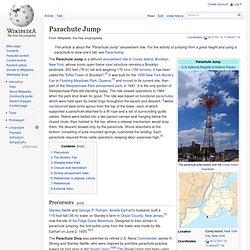
For the activity of jumping from a great height and using a parachute to slow one's fall, see Parachuting. The Parachute Jump is a defunct amusement ride in Coney Island, Brooklyn, New York, whose iconic open-frame steel structure remains a Brooklyn landmark. 250 feet (76 m) tall and weighing 170 tons (150 tonnes), it has been called the "Eiffel Tower of Brooklyn".[2] It was built for the 1939 New York World's Fair in Flushing Meadows Park, Queens,[3] and moved to its current site, then part of the Steeplechase Park amusement park, in 1941. It is the only portion of Steeplechase Park still standing today. The ride ceased operations in 1964 when the park shut down for good. The ride was based on functional parachutes which were held open by metal rings throughout the ascent and descent. Precursors[edit] Stanley Switlik and George P.
The Parachute Drop was patented by retired U.S. The World's Fair[edit] Interac. Interac Association is a Canadian organization linking enterprises that have proprietary networks so that they may communicate with each other for the purpose of exchanging electronic financial transactions. The Association was founded in 1984 as a cooperative venture between five financial institutions: Royal Bank of Canada, CIBC, Scotiabank, Toronto-Dominion Bank, and Desjardins. A 2010 request by Interac to become a for-profit organization was rejected by the Competition Bureau.[1] By 2010, there were over 80 member organizations and there were over 59,000 Automated Banking Machines that can be accessed through the Interac network in Canada and over 450,000 merchant locations accepting it.
Interac's head office is located at Royal Bank Plaza in Toronto. Services[edit] Interac Association is the organization responsible for the development of a national network of two shared electronic financial services: Interac Direct Payment (IDP)[edit] How Interac Direct Payment (IDP) works[edit] Physical attractiveness. Venus de Milo at the Louvre has been described as a "classical vision of beauty".[1][2][3] However, one expert claimed her "almost matronly" "representation" was meant to convey an "impressive appearance" rather than "ideal female beauty".[4] Ishtar, Mesopotamian goddess of sexual love and war.
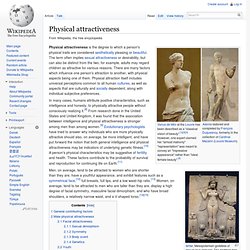
The goddess has been associated with sexuality, love, and fertility.[5][6][7] Physical attractiveness is the degree to which a person's physical traits are considered aesthetically pleasing or beautiful. The term often implies sexual attractiveness or desirability, but can also be distinct from the two; for example, adults may regard children as attractive for various reasons. There are many factors which influence one person's attraction to another, with physical aspects being one of them. General contributing factors[edit] Love styles. Love styles are modi operandi of how people love, originally developed by John Lee (1973,[1] 1988[2]).
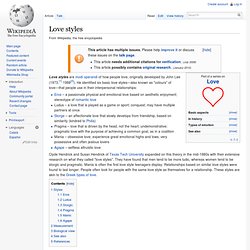
He identified six basic love styles—also known as "colours" of love—that people use in their interpersonal relationships: Clyde Hendrick and Susan Hendrick of Texas Tech University expanded on this theory in the mid-1980s with their extensive research on what they called "love styles". They have found that men tend to be more ludic, whereas women tend to be storgic and pragmatic.
Mania is often the first love style teenagers display. Relationships based on similar love styles were found to last longer. How to Live on 24 Hours a Day. How to Live on 24 Hours a Day (1910), written by Arnold Bennett, is part of a larger work entitled How to Live.
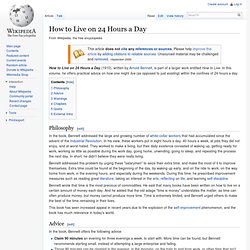
In this volume, he offers practical advice on how one might live (as opposed to just existing) within the confines of 24 hours a day. Philosophy[edit] In the book, Bennett addressed the large and growing number of white-collar workers that had accumulated since the advent of the Industrial Revolution. In his view, these workers put in eight hours a day, 40 hours a week, at jobs they did not enjoy, and at worst hated.
They worked to make a living, but their daily existence consisted of waking up, getting ready for work, working as little as possible during the work day, going home, unwinding, going to sleep, and repeating the process the next day. Bennett addressed this problem by urging these "salarymen" to seize their extra time, and make the most of it to improve themselves. Bennett wrote that time is the most precious of commodities.